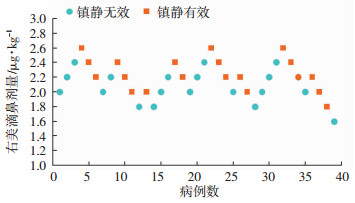2. 401331 重庆,重庆医科大学附属大学城医院麻醉科
2. Department of Anesthesiology, University-Town Hospital of Chongqing Medical University, Chongqing, 401331, China
小儿睡眠脑电图检查与清醒脑电图相比,能明显提高癫痫确诊率[1],但门诊患儿处于紧张和焦虑情绪时很难进入自然睡眠,因此,理想的方式是通过镇静药物使患儿达到睡眠状态[2]。目前认为,右美托咪定的镇静机制类似自然睡眠,对脑电基础背景波干扰较小,不影响痫样放电(棘波、尖波、棘尖/慢综合波、多棘尖/慢波群等)检出[3-4],可用于小儿睡眠脑电图检查。右美托咪定对黏膜无刺激作用,鼻腔内丰富的毛细血管利于药物吸收,其生物利用度可达65%[5]。无创的给药方式更能减轻患儿焦虑,增加父母的满意度。然而,目前右美托咪定滴鼻用于小儿脑电图检查有效剂量的相关研究甚少。因此,本研究主要通过患儿镇静下的入睡情况,利用序贯法调整用药剂量,拟对右美托咪啶滴鼻用于小儿睡眠脑电图检查的半数有效剂量和95%可信区间进行探讨,为临床用药提供参考。
1 资料与方法 1.1 一般资料经重庆医科大学附属儿童医院医学伦理委员会批准,批件号:(2016)年伦审(研)第(119)号,并获得患儿家属知情同意。选择拟行睡眠脑电图检查的患儿,美国麻醉医师协会(ASA)分级Ⅰ~Ⅱ级,年龄1~6岁,体质指数<25,性别不限。排除标准:合并鼻畸形可能出现药物吸收障碍;滴鼻后打喷嚏;存在困难气管插管的风险;有严重的脱水或营养不良。
1.2 麻醉方法所有患儿常规禁食4 h,禁饮2 h。将浓度为100 μg/mL的右美托咪定(江苏恒瑞医药有限公司)由刻度精确的1 mL空针除去针头从鼻孔滴入,并保持患儿仰卧位5 min以利于药物吸收。根据预试验结果,将第1例患儿的滴鼻剂量定为2.0 μg/kg,通过Ramsay镇静评分[6](ramsay sedation scale, RSS)(表 1)和睫毛反射消失,来确定下1例患儿所用右美托咪定剂量多少,按0.2 μg/kg阶梯增减。若前1例患儿RSS评分≥4分且睫毛反射消失,则纳入镇静有效组,下1例患儿减少1个剂量梯度;若前1例患儿滴鼻35 min后仍无法入睡,则纳入镇静无效组,下1例患儿则增加1个剂量梯度。镇静无效的患儿追加1.0 μg/kg右美托咪定,直至RSS评分≥4分、睫毛反射消失后进行脑电图检查。每10分钟记录1次呼吸频率(R)、心率(HR)、血压(BP)、血氧饱和度(SpO2),观察有无恶心呕吐、恶性心律失常、急性心力衰竭等不良反应,研究进行至阴性阳性结果达到8个拐点时终止实验[7]。滴鼻操作的护士不知道患儿是否纳入研究且不参与数据收集,进行数据采集的麻醉医师不知道患儿用药剂量。
| 分值 | 临床反应 |
| 1 | 患者焦虑、躁动不安 |
| 2 | 患者配合,有定向力,安静 |
| 3 | 患者仅对指令有反应 |
| 4 | 嗜睡,对轻扣眉间或大声听觉刺激反应敏捷 |
| 5 | 嗜睡,对轻扣眉间或大声听觉刺激反应迟钝 |
| 6 | 深睡状态,无任何反应 |
| ≥4分表示患儿处于镇静状态 | |
1.3 统计学分析
采用SPSS 22.0统计软件。计量资料以x±s表示,组间比较采用单因素方差分析,计数资料比较采用χ2检验,检验水准:α=0.05。通过Dixon和Massey方法[8-9],计算ED50及95% CI。
2 结果两组患儿性别、年龄、体质量等一般资料差异无统计学意义(表 2)。按Dxion序贯法进行试验,最终有39例患儿纳入研究(图 1)。通过公式计算得出右美托咪定滴鼻镇静用于小儿脑电图检查的ED50为2.10 μg/kg,95%CI为1.955~2.255 μg/kg(表 3)。纳入研究的39例患儿(出现痫样放电6例)中,镇静有效20例,镇静无效19例。利用受检期原始脑电图(使用日本光电EEG-9000,版本号05-70脑电图机,国际标准10-20电极系统进行采集,电极阻抗<5 kΩ)对镇静有效组患儿进行睡眠阶段分析,其结果:非快动眼睡眠(non-rapid eye movement,NREM)Ⅱ期16例,NREM Ⅲ期4例,未观察到NREMⅠ期。镇静无效组中有2例患儿在追加1.0 μg/kg右美托咪定后出现心率减慢,但均在5 min以内恢复至基础值20%范围内,无须干预性处理,没有患儿出现心律失常、心跳骤停、药物过敏等严重不良反应。

|
| 运用Dixon序贯法进行研究,第1例患儿初始剂量为2.0 μg/kg,以0.2 μg/kg阶梯增减,研究进行至第39例患儿终止 图 1 右美托咪定滴鼻镇静下脑电图检查患儿的序贯研究过程 |
| 组别 | n | 年龄 (岁) |
性别 (男/女) |
体质量 (kg) |
ASAⅠ/Ⅱ (例) |
| 镇静有效组 | 20 | 3.9±1.4 | 11/9 | 15.3±3.8 | 17/3 |
| 镇静无效组 | 19 | 4.0±1.7 | 12/7 | 15.9±5.0 | 18/1 |
| P | 0.201 | 0.424 | 0.183 | 0.322 |
| 剂量/μg·kg-1 | 剂量对数(x) | 镇静无效组/例 | 镇静有效组/例 | 合计/例 | 有效率(p) | n×x | p(1-p)/(n-1) |
| 1.6000 | 0.2041 | 1 | 0 | 1 | 0 | 0.2041 | 0 |
| 1.7632 | 0.2463 | 3 | 1 | 4 | 0.2500 | 0.9852 | 0.0625 |
| 1.9431 | 0.2885 | 7 | 4 | 11 | 0.3636 | 3.1735 | 0.0231 |
| 2.1414 | 0.3307 | 5 | 7 | 12 | 0.5833 | 3.9684 | 0.0221 |
| 2.3599 | 0.3729 | 3 | 5 | 8 | 0.6250 | 2.9832 | 0.0335 |
| 2.6088 | 0.4151 | 0 | 3 | 3 | 1 | 1.2453 | 0 |
| 合计 | 19 | 20 | 39 | 0.5128 | 12.5597 | 0.1412 | |
设x为剂量对数,根据公式lgED50=∑(n×x)/∑n=12.559 7/39=0.322 0,取反对数为ED50=2.10 μg/kg。标准误SlgED50=d =0.0422× =0.0422×  =0.0159, d为相邻剂量对数差值,95%CI的对数值为(lgED50-1.96SlgED50~IgED50+1.96SlgED50),取反对数可得ED50的95%CI为(1.955~2.255)μg/kg =0.0159, d为相邻剂量对数差值,95%CI的对数值为(lgED50-1.96SlgED50~IgED50+1.96SlgED50),取反对数可得ED50的95%CI为(1.955~2.255)μg/kg | |||||||
3 讨论
目前,口服水合氯醛是小儿门诊检查常用的镇静方式,虽然水合氯醛对脑电图影响较小,但可能伴有镇静失败、呼吸频率减慢、恶心呕吐,甚至死亡的风险[10-11]。相反,右美托咪定对呼吸循环抑制轻、镇静效果好、不良反应发生率小,是适用于小儿门诊的新型镇静药物[12]。右美托咪定通过激动突触前α2肾上腺素能受体,使蓝斑神经元超极化,抑制去甲肾上腺素释放,导致下丘脑腹外侧视前核活动增加,从而抑制上行唤醒回路[13-14]。激活视前核所导致的上行唤醒回路抑制机制被认为是非快动眼睡眠形成的重要机制之一,所以右美托咪定镇静和正常的非快动眼睡眠时期所出现的脑电波非常相似[15]。有研究表明,接受右美托咪定镇静治疗的患儿,脑电图中alpha、theta、beta活动有所增加,但delta活动和总的脑电功率并未受到影响,不会干扰脑电图判读[4]。因此,右美托咪定可用于小儿脑电图检查,但其滴鼻给药用于小儿脑电图检查的有效剂量却少见报道。
为了提高研究效率和简化研究过程,本研究采用序贯法进行试验。按Dixon和Massey方法中计算ED50和95%CI的序贯公式进行计算[16],所得结果ED50为2.10 μg/kg,95%CI为(1.955~2.255)μg/kg。以滴鼻的方式给药,无须建立静脉通道,既可减轻患儿的恐惧和痛苦,也能避免口服用药在肝脏和肠道产生的首过效应。右美托咪定经鼻给予和静脉注射,在人体内的药理作用是相似的,鼻内给予右美托咪定,在35~45 min后血药浓度可达峰值,一般在给药35 min后患儿就能获得足够的镇静[17]。因此,本研究将滴鼻35 min后无法入睡定义为镇静无效。
纳入本次研究的39例患儿中,对镇静有效组中20例患儿的睡眠阶段进行分析[18],有16例(80%)患儿处于非快动眼睡眠(non-rapid eye movement,NREM)Ⅱ期,只有4例(20%)患儿处于NREM Ⅲ期。这20例患儿中大部分无法观察到NREMⅠ期,偶尔出现的NREMⅠ期时限也较短,仅持续几秒就很快过渡到NREMⅡ阶段。分析其原因:可能是由于门诊条件限制,年龄较小的患儿在入睡前拒绝安放电极,无法进行从清醒到入睡的全程脑电图采集,因此很难观察到NREMⅠ期。文献[19]报道,痫样放电在睡眠期检出率明显高于觉醒期,在NREMⅠ~Ⅱ期时,小儿痫样放电检出率高达90.3%。本研究发现,右美托咪定滴鼻镇静下有80%的患儿镇静深度集中在异常放电检出率较高的NREMⅡ期阶段。
综上所述,右美托咪定滴鼻镇静用于小儿脑电图检查的半数有效剂量为2.10 μg/kg,95%可信区间为(1.955~2.255)μg/kg。序贯试验的优点之一是节约样本量,但同时小样本量的限制也会导致一定的局限[20]。在本研究中,想要探究睡眠阶段与给药剂量之间的关系,还需更大的样本量来完成。下一步我们将继续探讨右美托咪定滴鼻剂量与小儿睡眠阶段分期的相关性。
| [1] | SENEVIRATNE U, COOK M J, D'SOUZA W J. Electroencephalography in the diagnosis of genetic generalized epilepsy syndromes[J]. Front Neurol, 2017, 8: 499. DOI:10.3389/fneur.2017.00499 |
| [2] | KEIDAN I, BEN-MENACHEM E, TZADOK M, et al. Electroencephalography for children with autistic spectrum disorder: a sedation protocol[J]. Paediatr Anaesth, 2015, 25(2): 200–205. DOI:10.1111/pan.12510 |
| [3] | CHAITANYA G, ARIVAZHAGAN A, SINHA S, et al. Dexmedetomidine anesthesia enhances spike generation during intra-operative electrocorticography: a promising adjunct for epilepsy surgery[J]. Epilepsy Res, 2015, 109: 65–71. DOI:10.1016/j.eplepsyres.2014.10.006 |
| [4] | MASON K P, O'MAHONY E, ZURAKOWSKI D, et al. Effects of dexmedetomidine sedation on the EEG in children[J]. Paediatr Anaesth, 2009, 19(12): 1175–1183. DOI:10.1111/j.1460-9592.2009.03160.x |
| [5] |
奚晓雁, 肖宇, 周淑辉. 右美托咪定滴鼻镇静术预防儿童牙科焦虑症的有效剂量分析[J].
海南医学, 2017, 27(8): 1260–1262.
XI X Y, XIAO Y, ZHOU S H. Effective dose of dexmedetomidine nasal sedation in prevention of dental anxiety disorder in children[J]. Hainan Med J, 2017, 27(8): 1260–1262. DOI:10.3969/j.issn.1003-6350.2017.08.019 |
| [6] | RAMASWAMY S S, PARIMALA B. Comparative evaluation of two different loading doses of dexmedetomidine with midazolam-fentanyl for sedation in vitreoretinal surgery under peribulbar anaesthesia[J]. Indian J Anaesth, 2016, 60(2): 89–93. DOI:10.4103/0019-5049.176277 |
| [7] |
徐颖怡, 宋兴荣, 张国强. 右美托咪啶滴鼻诱导CT检查患儿睡眠的半数有效剂量[J].
中华医学杂志, 2014, 94(24): 1886–1888.
XU Y Y, SONG X R, ZHANG G Q. ED50 dexmedetomidine nasal drip in induction of hypnosis in children during computed tomography[J]. Natl Med J China, 2014, 94(24): 1886–1888. DOI:10.3760/cma.j.issn.0376-2491.2014.24.012 |
| [8] | DIXON W J, MASSEY F J. Introduction to statistical analysis[M]. 4thed. New York: McGraw-Hill, 1983: 426-441. |
| [9] |
许幸, 魏秀兰, 吴新民. 序贯试验法测定异丙酚诱导时的BIS50和ED50[J].
中华麻醉学杂志, 2001, 21(1): 7–9.
XU X, WEI X L, WU X M. Determination of BIS50 and ED50 for propofol during induction by sequential experimental method[J]. Chin J Anesthesia, 2001, 21(1): 7–9. DOI:10.3760/j.issn:0254-1416.2001.01.002 |
| [10] | YUEN V M, LI B L, CHEUK D K, et al. A randomised controlled trial of oral chloral hydrate vs. intranasal dexmedetomidine before computerised tomography in children[J]. Anaesthesia, 2017, 72(10): 1191–1195. DOI:10.1111/anae.13981 |
| [11] | COZZI G, NORBEDO S, BARBI E. Intranasal dexmedetomidine for procedural sedation in children, a suitable alternative to chloral hydrate[J]. Paediatr Drugs, 2017, 19(2): 107–111. DOI:10.1007/s40272-017-0217-5 |
| [12] | GUMUS H, BAYRAM A K, POYRAZOGLU H G, et al. Comparison of effects of different dexmedetomidine and chloral hydrate doses used in sedation on electroencephalography in pediatric patients[J]. J Child Neurol, 2015, 30(8): 983–988. DOI:10.1177/0883073814549582 |
| [13] | MAHMOUD M, MASON K P. Dexmedetomidine: review, update, and future considerations of paediatric perioperative and periprocedural applications and limitations[J]. Br J Anaesth, 2015, 115(2): 171–182. DOI:10.1093/bja/aev226 |
| [14] | PURDON P L, SAMPSON A, PAVONE K J, et al. Clinical electroencephalography for anesthesiologists: Part I: background and basic signatures[J]. Anesthesiology, 2015, 123(4): 937–960. DOI:10.1097/ALN.0000000000000841 |
| [15] | KIM W H, CHO D, LEE B, et al. Changes in brain activation during sedation induced by dexmedetomidine[J]. J Int Med Res, 2017, 45(3): 1158–1167. DOI:10.1177/0300060517705477 |
| [16] | IIROLA T, VILO S, MANNER T, et al. Bioavailability of dexmedetomidine after intranasal administration[J]. Eur J Clin Pharmacol, 2011, 67(8): 825–831. DOI:10.1007/s00228-011-1002-y |
| [17] | TUG A, HANCI A, TURK H S, et al. Comparison of two different intranasal doses of dexmedetomidine in children for magnetic resonance imaging sedation[J]. Paediatr Drugs, 2015, 17(6): 479–485. DOI:10.1007/s40272-015-0145-1 |
| [18] | FERNANDES M L, OLIVEIRA W M, SANTOS MDO C, et al. Sedation for electroencephalography with dexmedetomidine or chloral hydrate: a comparative study on the qualitative and quantitative electroencephalogram pattern[J]. J Neurosurg Anesthesiol, 2015, 27(1): 21–25. DOI:10.1097/ANA.0000000000000077 |
| [19] |
杨晓燕, 龙莉莉, 肖波. 视频脑电图在儿童癫癎诊断及定位中的作用[J].
中国当代儿科杂志, 2016, 18(10): 971–974.
YANG X Y, LONG L L, XIAO B. Role of video electroencephalogram in diagnosis and localization of epilepsy in children[J]. Chin J Contemp Pediatr, 2016, 18(10): 971–974. DOI:10.7499/j.issn.1008-8830.2016.10.010 |
| [20] | LIU Y, YU Q, SUN M, et al. Median effective dose of intranasal dexmedetomidine sedation for transthoracic echocardiography examination in postcardiac surgery and normal children: An up-and-down sequential allocation trial[J]. Eur J Anaesthesiol, 2018, 35: 1. DOI:10.1097/EJA.0000000000000724 |



